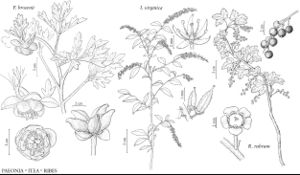Paeonia
Sp. Pl. 1: 530. 1753.
Gen. Pl. ed. 5, 235. 1754 ,.
| Taxon | Illustrator ⠉ | |
|---|---|---|
 | Ribes rubrum Paeonia Paeonia brownii Itea Itea virginica | Barbara Alongi John Myers John Myers Barbara Alongi Barbara Alongi |
Herbs 20–75 [–200+] cm, usually rhizomatous and/or roots notably fleshy or thickened. Leaves (excluding clasping, scalelike structures proximal to leaves proper) mostly 5–12 per shoot. Inflorescences: flowers nodding [erect], sometimes surpassed by foliage or individual flower overtopped by ± leaflike bract. Flowers often fragrant, showy; sepals usually persistent, usually green or purplish; petals dark red to purplish, almost black, or maroon to bronze [pink, red, white, yellow], usually with contrasting margins. Follicles usually ± leathery. Seeds relatively large. x = 5.
Distribution
w United States, nw Mexico, Eurasia
Discussion
Species ca. 30 (2 in the flora).
Peonies have been cultivated for centuries for horticultural and medicinal uses. Hundreds of “single” and “double” cultivars are available in the horticultural trade. Cultivars of Paeonia lactiflora Pallas (petals mostly white to pink), P. officinalis Linnaeus (follicles tomentose), and P. suffruticosa Andrews (plants ± shrubby) may be found in the flora area as escapes from cultivation.
Selected References
None.
Lower Taxa
Key
| 1 | Plants 20-40 cm; leaves usually 5-8 per shoot, bases of primary divisions notably narrowed (stalklike), ultimate divisions mostly elliptic to obovate, apices usually obtuse to rounded, surfaces usually ± glaucous; petals orbiculate, usually shorter than inner sepals. | Paeonia brownii |
| 1 | Plants 35-75 cm; leaves usually 7-12 per shoot, bases of primary divisions not notably narrowed (not stalklike), ultimate divisions linear to spatulate, apices usually acute, surfaces not notably glaucous; petals elliptic, usually longer than inner sepals. | Paeonia californica |